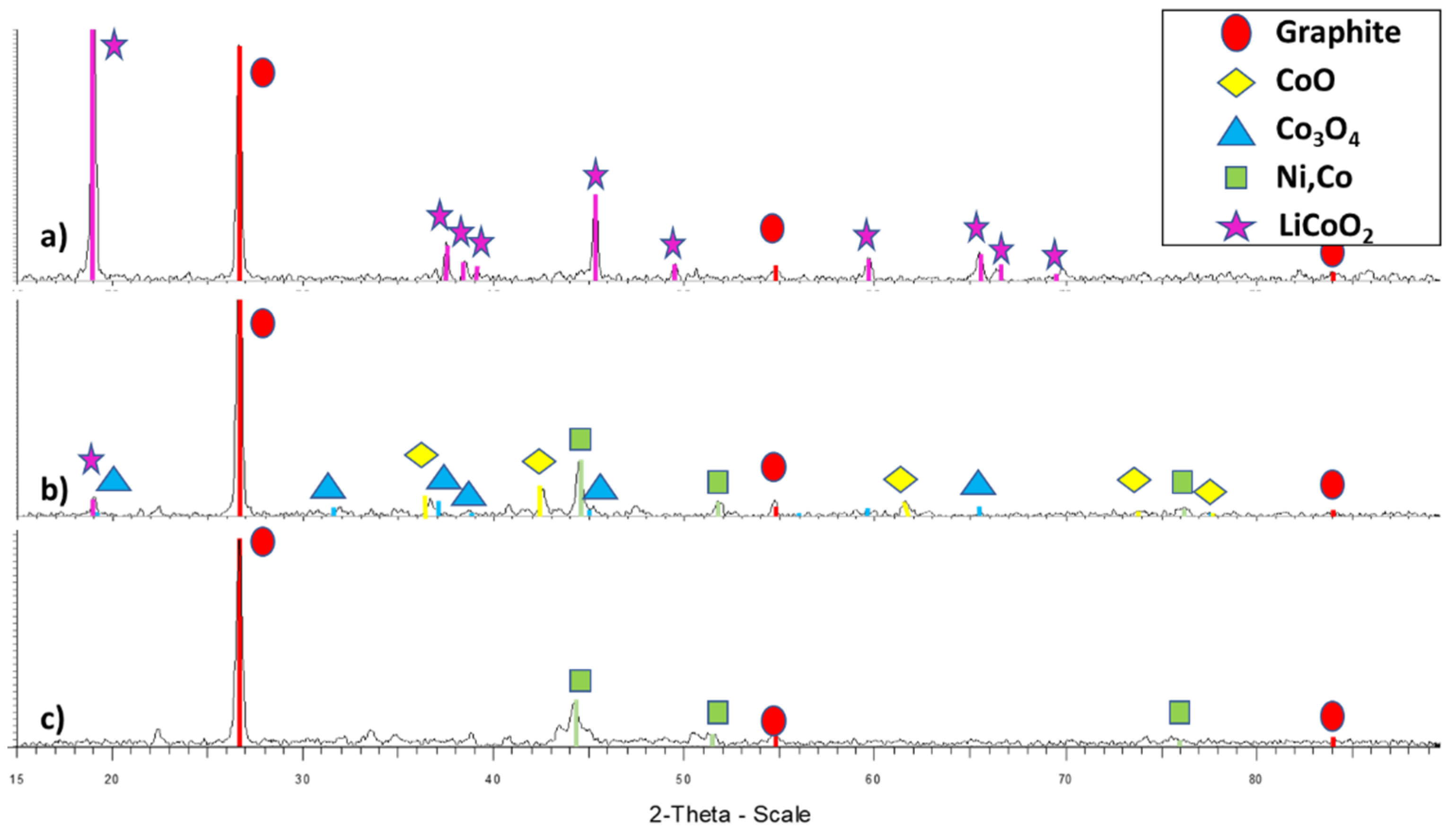A Sustainable Process for the Recovery of Valuable Metals from Spent Lithium Ion Batteries by Deep Eutectic Solvents Leaching †
Abstract
:1. Introduction
2. Materials and Methods
2.1. Chemical Reagents
2.2. Spent Lithium Ion Battery Residues
2.3. Leaching Procedure
2.4. Analytical Techniques
2.4.1. Metal Composition
2.4.2. Mineralogy
3. Results and Discussion
3.1. Sample Characterization
- -
- LiCoO2 containing BMs (samples A, E, H, I, J, and Q);
- -
- Co oxides (CoO, Co3O4 [CoO, Co2O3]) containing BMs (samples B, C, D, F, K, L, and N);
- -
- Metallic Co, Ni containing rich BMs (samples G, O, and P).
3.2. Leaching Experiments
4. Conclusions
Author Contributions
Funding
Institutional Review Board Statement
Informed Consent Statement
Data Availability Statement
Conflicts of Interest
References
- Holland, A.; Jiao, N. End-of-Life Electric Vehicle Batteries: Recycling or Second-Life? Idtechex. 2021. Available online: https://www.idtechex.com/de/research-article/end-of-life-electric-vehicle-batteries-recycling-or-second-life/20900 (accessed on 6 February 2021).
- Lin, X.; Salari, M.; Arava, L.M.R.; Ajayan, P.M.; Grinstaff, M.W. High temperature electrical energy storage: Advances, challenges, and frontiers. Chem. Soc. Rev. 2016, 45, 5848–5887. [Google Scholar] [CrossRef] [PubMed]
- Zhao, X.Q.; Veintemillas-Verdaguer, S.; Bomati-Miguel, O.; Morales, M.P.; Xu, H.B. Thermal history dependence of the crystal structure of Co fine particles. Phys. Rev. B Condens. Matter Mater. Phys. 2005, 71, 024106. [Google Scholar] [CrossRef]
- Cendrowski, K.; Zenderowska, A.; Bieganska, A.; Mijowska, E. Graphene nanoflakes functionalized with cobalt/cobalt oxides formation during cobalt organic framework carbonization. Dalt. Trans. 2017, 46, 7722–7732. [Google Scholar] [CrossRef] [PubMed]
- Khan, I.A.; Nasim, F.; Choucair, M.; Ullah, S.; Badshah, A.; Nadeem, M.A. Cobalt oxide nanoparticle embedded N-CNTs: Lithium ion battery applications. RSC Adv. 2016, 6, 1129–1135. [Google Scholar] [CrossRef]
- Musariri, B.; Akdogan, G.; Dorfling, C.; Bradshaw, S. Evaluating organic acids as alternative leaching reagents for metal recovery from lithium ion batteries. Miner. Eng. 2019, 137, 108–117. [Google Scholar] [CrossRef]
- Nayaka, G.P.; Zhang, Y.; Dong, P.; Wang, D.; Zhou, Z.; Duan, J.; Li, X.; Lin, Y.; Meng, Q.; Pai, K.V.; et al. An environmental friendly attempt to recycle the spent Li-ion battery cathode through organic acid leaching. J. Environ. Chem. Eng. 2019, 7, 102854. [Google Scholar] [CrossRef]
- Wang, S.; Zhang, Z.; Lu, Z.; Xu, Z. A novel method for screening deep eutectic solvent to recycle the cathode of Li-ion batteries. Green Chem. 2020, 22, 4473–4482. [Google Scholar] [CrossRef]
- Tran, M.K.; Rodrigues, M.T.F.; Kato, K.; Babu, G.; Ajayan, P.M. Deep eutectic solvents for cathode recycling of Li-ion batteries. Nat. Energy 2019, 4, 339–345. [Google Scholar] [CrossRef]
- Li, L.; Dunn, J.B.; Zhang, X.X.; Gaines, L.; Chen, R.J.; Wu, F.; Amine, K. Recovery of metals from spent lithium-ion batteries with organic acids as leaching reagents and environmental assessment. J. Power Sources 2013, 233, 180–189. [Google Scholar] [CrossRef]
- Nayaka, G.P.; Zhang, Y.; Dong, P.; Wang, D.; Pai, K.V.; Manjanna, J.; Santhosh, G.; Duan, J.; Zhou, Z.; Xiao, J. Effective and environmentally friendly recycling process designed for LiCoO2cathode powders of spent Li-ion batteries using mixture of mild organic acids. Waste Manag. 2018, 78, 51–57. [Google Scholar] [CrossRef] [PubMed]
- European Commission. Cobalt and Lanthanide Recovery from Batteries (COLABATS). Available online: https://cordis.europa.eu/project/id/603482/es (accessed on 7 June 2021).
- European Commission. Integrated High Temperature Electrolysis (HTE) and Ion Liquid Extraction (ILE) for a Strong and Independent European Rare Earth Elements Supply Chain (REE4EU). Available online: https://cordis.europa.eu/project/id/680507/es (accessed on 7 June 2021).



 |  |  |
| Choline Chloride (33%) | Lactic Acid (53%) | Citric Acid (13%) |
| Leaching Temperature (°C) | Co Leaching Yield (%) | Leaching Time (h) |
|---|---|---|
| 55 | 94 | 7.5 |
| 70 | >99 | 4.8 |
| 85 | >99 | 3.1 |
| Sample Ref. | Leaching Yield (No Additives) | Leaching Yield (Additives) |
|---|---|---|
| A | 94 | 98 |
| B | 39 | 92 |
| F | 87 | >99 |
| G | 4.7 | 92 |
Publisher’s Note: MDPI stays neutral with regard to jurisdictional claims in published maps and institutional affiliations. |
© 2022 by the authors. Licensee MDPI, Basel, Switzerland. This article is an open access article distributed under the terms and conditions of the Creative Commons Attribution (CC BY) license (https://creativecommons.org/licenses/by/4.0/).
Share and Cite
Yurramendi, L.; Hidalgo, J.; Siriwardana, A. A Sustainable Process for the Recovery of Valuable Metals from Spent Lithium Ion Batteries by Deep Eutectic Solvents Leaching. Mater. Proc. 2021, 5, 100. https://doi.org/10.3390/materproc2021005100
Yurramendi L, Hidalgo J, Siriwardana A. A Sustainable Process for the Recovery of Valuable Metals from Spent Lithium Ion Batteries by Deep Eutectic Solvents Leaching. Materials Proceedings. 2021; 5(1):100. https://doi.org/10.3390/materproc2021005100
Chicago/Turabian StyleYurramendi, Lourdes, Jokin Hidalgo, and Amal Siriwardana. 2021. "A Sustainable Process for the Recovery of Valuable Metals from Spent Lithium Ion Batteries by Deep Eutectic Solvents Leaching" Materials Proceedings 5, no. 1: 100. https://doi.org/10.3390/materproc2021005100






